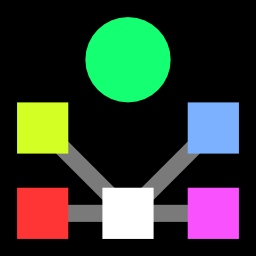Statistics
A network statistic is a numerical value that characterizes a
network. Examples of network statistics are the number of nodes and the
number of edges in a network, but also more complex measures such as the
diameter and the clustering coefficient.
Statistics are the basis of most network analysis methods; they can
be used to compare networks, classify networks, detect anomalies in
networks and for many other tasks. Network statistics are also used to
map a network's structure to a simple numerical space, in which many
standard statistical methods can be applied. Thus, network statistics
are essential for the analysis of almost all network types.
All statistics described in KONECT are real numbers.
The following statistics are computed for the networks in KONECT. Not
all statistics are computed for all networks. Some statistics only apply
to certain kinds of networks (e.g., the clustering coefficient only
applies to unipartite networks). For very large networks, some
statistics are not computed because the computations take too long.
| n = | Size | ∈ ℕ
|
| m = | Volume | ∈ ℕ
|
| m̿ = | Unique edge count | ∈ ℕ
|
| l = | Loop count | ∈ ℕ
|
| s = | Wedge count | ∈ ℕ
|
| z = | Claw count | ∈ ℕ
|
| x = | Cross count | ∈ ℕ
|
| t = | Triangle count | ∈ ℕ
|
| q = | Square count | ∈ ℕ
|
| T4 = | 4-Tour count | ∈ ℕ
|
| dmax = | Maximum degree | ∈ ℕ
|
| d = | Average degree | ∈ ℝ⁺
|
| p = | Fill | ∈ [0, 1]
|
| m̃ = | Average edge multiplicity | ∈ ℝ⁺
|
| N = | Size of LCC | ∈ ℕ
|
| Ns = | Size of LSCC | ∈ ℕ
|
| δ = | Diameter | ∈ ℕ
|
| δ0.5 = | 50-Percentile effective diameter | ∈ ℝ⁺
|
| δ0.9 = | 90-Percentile effective diameter | ∈ ℝ⁺
|
| δM = | Median distance | ∈ ℕ
|
| δm = | Mean distance | ∈ ℝ⁺
|
| G = | Gini coefficient | ∈ [0, 1]
|
| P = | Balanced inequality ratio | ∈ [0, 1]
|
| Her = | Relative edge distribution entropy | ∈ [0, 1]
|
| γ = | Power law exponent | ∈ ℝ⁺
|
| γt = | Tail power law exponent | ∈ ℝ⁺
|
| γ3 = | Tail power law exponent with p | ∈ ℝ⁺
|
| ρ = | Degree assortativity | ∈ [−1, +1]
|
| ρ± = | In/outdegree correlation | ∈ [−1, +1]
|
| c = | Clustering coefficient | ∈ [0, 1]
|
| c± = | Directed clustering coefficient | ∈ [0, 1]
|
| α = | Spectral norm | ∈ ℝ⁺
|
| ν = | Operator 2-norm | ∈ ℝ⁺
|
| π = | Cyclic eigenvalue | ∈ ℝ⁺
|
| a = | Algebraic connectivity | ∈ ℝ⁺
|
| |λ1[A] / λ2[A]| = | Spectral separation | ∈ ℝ⁺
|
| y = | Reciprocity | ∈ [0, 1]
|
| bA = | Non-bipartivity | ∈ [0, 1]
|
| bN = | Normalized non-bipartivity | ∈ [0, 1]
|
| χ = | Algebraic non-bipartivity | ∈ ℝ⁺
|
| bK = | Spectral bipartite frustration | ∈ [0, 1]
|
| ζ = | Negativity | ∈ [0, 1]
|
| ξ = | Algebraic conflict | ∈ ℝ⁺
|
| τ = | Triadic conflict | ∈ [0, 1]
|
| φ = | Spectral signed frustration | ∈ [0, 1]
|
| C = | Controllability | ∈ ℕ
|
 KONECT ‣
Buy Me a Coffee
KONECT ‣
Buy Me a Coffee